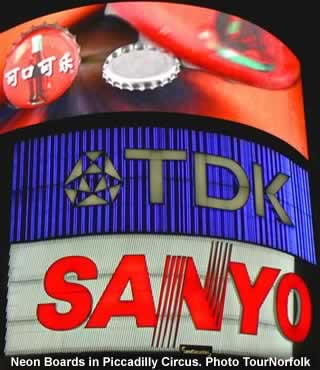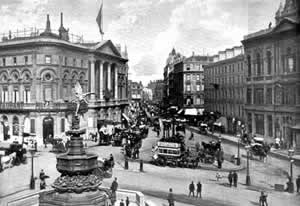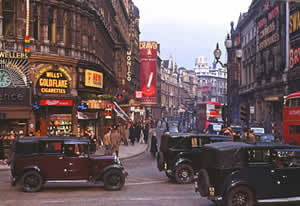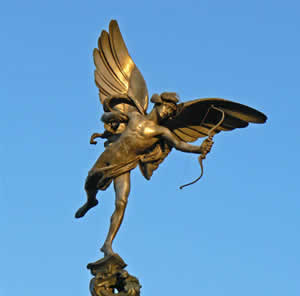Piccadilly Circus |
|
 |
|||
Marking the entrance into London’s entertainment district, with an array of neon advertising boards |
|||||
Listen to this article |
|||||
|
|||||
Piccadilly Circus marks the entrance into London’s lively entertainment district, with cinemas, theatres, night clubs, restaurants and pubs. It is famous for its array of neon advertising boards all located on the building between Shaftsbury Avenue and Glasshouse Street. World famous brands are displayed on state-of-the-art video displays that curve around the building, with the latest additions being ticker tape style news headlines. |
|||||
 Criterion Theatre Photo TourNorfolk |
|||||
 |
|||||
The name Piccadilly comes from a type of starched collar called a “piccadil”, sold by Robert Baker, a local merchant who had a house that became known as Piccadilly Hall during the 17th century. During the 19th century, the area was redesigned by John Nash and a circular open space was created on the junction of Regent Street. The tube station was opened in 1906, and the first electric advertising signs appeared in 1910. Over the years, the area has been constantly changed to handle the ever increasing amount of traffic in the area. |
|||||
 Piccadilly Circus in 1896 Photo in the public domain |
|||||
 Piccadilly Circus in 1949 Photo Chalmers Butterfield |
|||||
At the south-west corner of the circus you will find the statue of Eros, unveiled in 1893 as a memorial to the Earl of Shaftesbury, a Victorian philanthropist. It was one of the first public statues in the world to be cast in aluminium and intended to represent the Angel of Christian Charity; but since it was a nude statue carrying a bow and arrow, it became known as Eros, after the Greek mythical god of love. The use of a nude figure for a public monument was controversial at the time of its construction, but it has been generally well received by the public and over time, the statue has become a London icon. |
|||||
 The statue of Eros Photo TourNorfolk |
|||||
|
|||||
|
Pocket Britain is optimised for use on a smartphone or tablet with internet access. All content is subject to copyright. All reasonable methods have been used to ensure information supplied is accurate at the time of publication. However, it is advisable to check information before relying on it. Privacy Policy |